The Evolution of Virtual Reality Software: A Brief History
Virtual Reality (VR) is a technology that has been evolving for decades,offering users immersive experiences by simulating environments that can be similar to or completely different from the real world.The journey of VR software from its inception to the present day is a fascinating tale of innovation,experimentation,and technological breakthroughs.
Early Beginnings
The concept of VR can be traced back to the 1960s with the development of the first VR head-mounted display (HMD) called the "Sword of Damocles" by Ivan Sutherland and Bob Sproull.However,the software to support such a device was in its infancy and primarily limited to research and military applications.
The 1980s and 1990s: The Golden Age of VR
The 1980s saw the commercialization of VR with the release of products like the "VPL Research Eyephone" and "Virtuality 1000CS." The software during this period was rudimentary but allowed users to interact with 3D objects in a virtual space.Games like "Battlezone" and "Megazone" were among the first to experiment with VR concepts.
1990s to Early 2000s: The First Consumer VR Headsets
In the 1990s,companies like Sega and Nintendo tried to bring VR to the mass market with products like the "Sega VR" and the "Virtual Boy." However,due to various technical and commercial challenges,these products did not achieve the success expected.The software developed for these platforms was limited and often criticized for causing motion sickness and other discomforts.
Mid-2000s to 2010s: A Lull and the Birth of Modern VR
For a while,the VR industry experienced a lull,but research and development continued in the background.It was not until the mid-2000s that we started to see significant advancements in VR technology.The introduction of motion tracking and the rise of 3D graphics allowed for more realistic and interactive VR experiences.The "Second Life" platform was a significant milestone in social VR software,allowing users to interact in a virtual world.
2010s: The Resurgence and Maturation of VR
The 2010s marked the resurgence of VR with the introduction of the Oculus Rift Development Kit in 2012,which was funded through a highly successful Kickstarter campaign.This was followed by other major players entering the market with their VR headsets,such as the HTC Vive and Sony's PlayStation VR.The software ecosystem began to grow rapidly,with developers creating experiences ranging from games to educational and therapeutic applications.
2016: The Year of VR
Many consider 2016 as the year that VR truly became a mainstream technology.The release of the consumer version of the Oculus Rift,HTC Vive,and PlayStation VR brought high-quality VR experiences to the average consumer.The software available for these platforms was diverse,including popular titles like "Tilt Brush," "Job Simulator," and "Minecraft VR."
Present Day: The Expansion of VR Software
Today,VR software continues to expand across various industries.From gaming and entertainment to education,healthcare,and engineering,the applications of VR are seemingly limitless.Virtual reality is now an integral part of training programs,allowing for safe and effective simulations in fields such as surgery,pilot training,and military exercises.The rise of social VR platforms like "VRChat" and "Rec Room" has also shown the potential for virtual social interactions.
Future Outlook
The future of VR software is promising,with ongoing research in areas such as haptic feedback,eye tracking,and brain-computer interfaces. As the technology becomes more accessible and user-friendly,we can expect VR to play an even more significant role in our daily lives,revolutionizing the way we work,learn,and interact with each other.
As the technology becomes more accessible and user-friendly,we can expect VR to play an even more significant role in our daily lives,revolutionizing the way we work,learn,and interact with each other.
Conclusion
The evolution of VR software has been a journey of trial and error,with each step forward building on the lessons learned from the past.From its early beginnings to the present day,VR has transformed from a niche technology to a tool with widespread applications.As the technology continues to advance,the possibilities for VR software are as boundless as the imagination of its creators and users.
Key Milestones in VR Software History
-
1960s
The "Sword of Damocles" and the dawn of VR research.
-
1980s
Commercialization of VR with products like the "VPL Research Eyephone."
-
1990s
Attempts to bring VR to the mass market with "Sega VR" and "Virtual Boy."
-
Mid-2000s
Advancements in motion tracking and 3D graphics lead to more realistic VR experiences.
-
2010s
Introduction of the Oculus Rift Development Kit and the rise of modern consumer VR.
-
2016
Release of consumer versions of major VR headsets marks the year of VR.
-
Present Day
VR software expands across industries,with ongoing advancements in technology.
References
For further reading and a deeper understanding of the history of VR software,you may refer to the following sources:
- "The Ultimate History of Virtual Reality" by Tom Boellstorff.
- "VR: The History and Future of Virtual Reality" by David J.Gibson.
- "Virtual Reality: A Guide for the Creative and Curious" by Charles Dodd and Adriana de Souza e Silva.
Comment